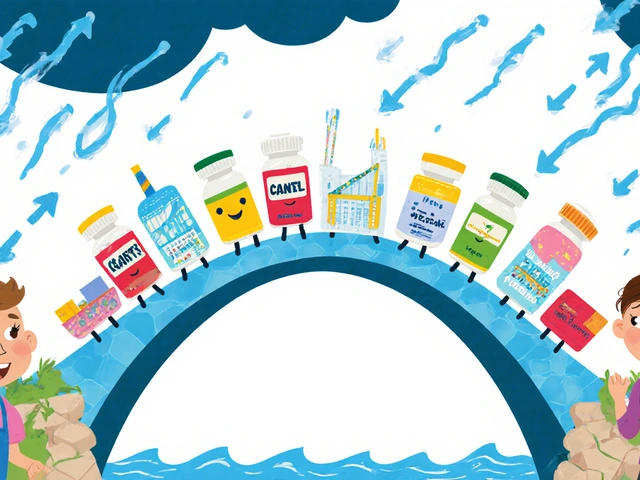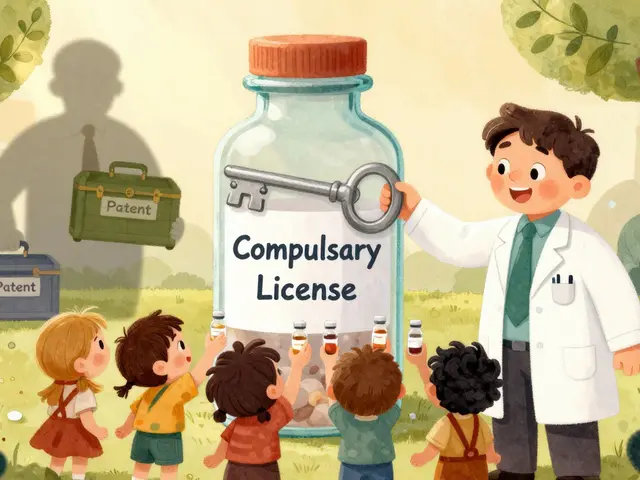Big promises, small print-that’s the usual story with herbal “immune boosters.” If you landed here after searching for Septilin, you probably want straight answers: what it is, whether it works, how to use it safely, and where to find the official product without getting burned by fakes. You’ll get that here, in plain English, with realistic expectations and clear next steps.
Find the official Septilin page and avoid fakes
Septilin is a branded polyherbal supplement from Himalaya Wellness (the Indian company known for Liv.52 and Ashwagandha). There are tablets and syrup formats. Because it’s popular and easy to ship, counterfeits do exist-especially on third‑party marketplaces. Start with the manufacturer’s page, then branch out.
Fastest way to reach the official product page:
- Search for “Himalaya Wellness Septilin official.”
- Open the result from the official Himalaya Wellness Company site (look for the himalayawellness domain and brand visuals that match Himalaya’s global site). Avoid URLs with odd spellings or extra hyphens.
- On the product page, note the exact product names (Septilin Tablets and Septilin Syrup), pack sizes, and the ingredient list as shown by the manufacturer. Save a screenshot so you can match it later when shopping.
- Use the site’s Store Locator or “Where to Buy” if available. In some regions you’ll be directed to authorized distributors. If the brand lists an official Amazon Store, use that rather than random marketplace sellers.
How to spot a genuine pack:
- Packaging quality: crisp print, clean seals, batch number, and expiry date. No spelling mistakes.
- Consistent branding: same logo, color palette, and bottle/tablet images as the manufacturer page for your region.
- Traceability: batch number and manufacturing license numbers visible on the carton/bottle.
- Reasonable price: deep discounts are a red flag for counterfeit or expired stock.
Here in Bristol, I mostly see Septilin online rather than at high-street chains. If you find it in a small shop, check the importer details and ask for proof of supply from an authorized distributor.
| Before you buy | What “good” looks like | Why it matters |
|---|---|---|
| Seller | Official brand store or retailer named by Himalaya | Cuts risk of counterfeit or mishandled stock |
| Packaging | Batch no., Mfg/Expiry date, intact seal, clean print | Traceability and freshness |
| Label | Ingredients and directions match manufacturer page | Confirms formulation and dosing |
| Price | Within typical range for region (no extreme discounts) | Unreal prices often signal fakes or expired stock |
| Returns | Clear return/refund policy, invoice provided | Consumer protection if the product is faulty |
UK angle (2025): Septilin is usually sold as a food supplement here, not as a licensed medicine. That means no approved medical claims, and quality varies by importer. The MHRA’s Traditional Herbal Registration (THR) scheme covers some herbal medicines, but Septilin does not commonly appear under THR in the UK. If a listing claims “MHRA approved,” be cautious and verify.
What Septilin is-and what the evidence really says
What it is: Septilin is a proprietary Ayurvedic blend. Depending on market, the label typically highlights ingredients like Tinospora cordifolia (Guduchi), Glycyrrhiza glabra (Licorice), and Indian bdellium (Guggul), with other botanicals varying by region. The exact composition and milligram amounts can differ, so go by your pack’s label.
What it’s marketed for: general “immune support” and respiratory health; sometimes positioned as an adjunct during infections such as tonsillitis or sinusitis. Those are marketing messages-you still need to look at data.
What the research says:
- Small trials in India (some randomized, some open-label) have reported fewer or milder upper respiratory infections and faster symptom relief when Septilin was added to standard care for conditions like chronic tonsillitis. Study sizes were modest, follow-up was short, and reporting of methods was often incomplete.
- No large, modern, placebo-controlled trials that meet high regulatory standards have confirmed these effects. There’s no MHRA or EMA approval for treating or preventing any disease.
- Some individual botanicals in the blend have lab or early clinical signals (for example, Tinospora for immune modulation, Licorice for soothing mucosa), but the whole product’s effect depends on the full formula and quality control.
- Safety signals exist: case reports in peer‑reviewed journals have linked Tinospora cordifolia to herb‑induced liver injury in susceptible people. Licorice can raise blood pressure and lower potassium in high doses. Guggul can irritate the gut and may affect certain medications.
How to read this as a consumer: there’s suggestive but limited evidence for symptom support in recurrent respiratory issues, and there are safety caveats. If you want something with proven impact on severe respiratory illness, think vaccines, hand hygiene, and addressing vitamin D deficiency if present-those are backed by strong evidence in UK guidance.
Practical rule of thumb:
- Use Septilin, if you choose to, as a short-term adjunct to healthy basics (sleep, nutrition, hydration), not as a replacement for medical care.
- Set a clear trial window (for example, 4-8 weeks), track symptoms, and stop if you see no meaningful benefit or if you notice side effects.
Who might consider it:
- Adults with frequent seasonal URTI who’ve tried the basics and want an adjunct, understanding the evidence is limited.
- People seeking a plant-based option to soothe irritated throat and sinuses alongside standard care.
Who should not self‑start it:
- Pregnant or breastfeeding people.
- Anyone with liver disease, autoimmune conditions, or a history of herb-induced liver injury.
- Transplant recipients or those on immunosuppressants.
- People on multiple medications with narrow therapeutic windows (for example, warfarin).
Sources behind these points include the manufacturer’s product monographs, small Indian clinical studies on adjunctive use in ENT infections, UK regulator guidance on herbal products (MHRA THR scheme), and case series on Tinospora-related liver injury. Speak with a pharmacist or GP if you’re unsure-especially if you take prescription meds.

How to use it safely: dosage, timing, interactions, and a smart checklist
This is not medical advice. Follow your pack’s label and your clinician’s guidance. Because formulations and labels differ by market, always check your exact product.
Typical label directions (to give you a frame of reference):
- Tablets (adults): often 1-2 tablets, twice daily after meals. Many users set a 6-8 week review point.
- Syrup: usually aimed at those who dislike tablets. Doses vary by age/weight. In the UK, self-medicating children with herbal blends isn’t recommended without professional advice-ask a pharmacist or GP first.
When to take it:
- After food to reduce stomach upset.
- Keep a consistent schedule (e.g., breakfast and dinner).
Common side effects (usually mild):
- Digestive: bloating, nausea, loose stools.
- Headache or a mild rash in sensitive users.
Stop and seek help if you notice:
- Jaundice, dark urine, pale stools, right‑upper abdominal pain (possible liver issue).
- Severe rash, wheeze, or facial swelling (possible allergy).
- Blood pressure spikes, muscle weakness, or irregular heartbeat (possible licorice-related low potassium at higher intakes).
Key interactions to consider:
- Anticoagulants (e.g., warfarin): guggul and other botanicals may alter metabolism-monitor INR closely or avoid.
- Blood pressure medicines and diuretics: licorice can counteract them and lower potassium.
- Diabetes medicines: Tinospora may enhance glucose-lowering; watch for hypoglycemia.
- Immunosuppressants (e.g., post‑transplant): immune‑modulating herbs can interfere-avoid unless your specialist agrees.
Smart user checklist:
- Confirm the exact formula on your pack. Some regional versions vary.
- Start one new supplement at a time so you can attribute effects.
- Set a stop date in your calendar to reassess benefit vs risk.
- Track symptoms weekly (energy, throat irritation, number of cold days) to judge if it’s doing anything real.
- Store as directed-usually in a cool, dry place, away from sunlight.
Dose adjustments:
- Elderly or those with multiple medications: start at the lower end and check in with a clinician.
- Children: get pharmacist or GP advice first; do not extrapolate adult doses.
What to pair it with (evidence-based basics):
- Seasonal vaccines (flu, COVID) as advised by the NHS.
- Vitamin D if you’re deficient or during winter months in the UK (dose per NHS guidance).
- Sleep, hydration, salt-water gargles for sore throat, and nasal saline rinses for congestion.
What not to do:
- Don’t delay antibiotics or urgent care for suspected bacterial sinusitis, strep throat, or chest infection.
- Don’t double up with other licorice- or guggul-containing supplements without checking total intake.
UK buying guide, prices, alternatives, and quick answers
Availability (UK, 2025): You’ll mainly find Septilin online via global sellers. It’s not a mainstream stock item at major UK pharmacies. Expect delivery times of 3-10 days depending on the seller and whether it ships domestically or from abroad.
Typical prices I’ve seen as of this year (these are ballpark, not endorsements):
- Tablets (60’s): often £8-£14 depending on seller and shipping.
- Syrup (200 ml): often £6-£12.
Returns and authenticity matter more than shaving £2 off the price. Choose sellers with invoices, batch‑tracked stock, and clear returns.
If your goal is fewer colds or gentler symptoms, consider these evidence‑aligned options too:
- Vitamin D: check your status if you’re frequently indoors or during winter; supplement per NHS guidance.
- Nasal saline rinses: good for congestion and sinus hygiene.
- Honey for cough (age 1+): modest benefit for night cough in children and adults.
- Lifestyle: hand hygiene, sleep, and avoiding smoke exposure make a real difference.
When to see a doctor instead of self‑supplementing:
- High fever, breathing difficulty, chest pain, or symptoms lasting more than 10 days without improvement.
- Recurrent tonsillitis, sinusitis, or ear infections-these may need a plan beyond supplements.
- Any yellowing of the eyes/skin, dark urine, severe abdominal pain.
Quick answers (mini‑FAQ):
- Does Septilin “boost” immunity? No supplement “boosts” immunity in a magic way. At best, it may modulate immune responses and soothe symptoms. Evidence is limited.
- Can I take it with antibiotics? Many people use it as an adjunct. There’s no solid evidence of harmful interactions with common antibiotics, but check your meds and stop if you get unusual side effects.
- Is it safe for kids? The syrup is marketed for children in some countries, but UK practice is cautious with multi‑herb blends. Ask a pharmacist/GP before using in children.
- How long should I take it? Commonly 4-8 weeks, then reassess. Long, indefinite use isn’t well studied.
- Is it vegan or halal? Formulas are plant‑based, but excipients vary by region. Check your pack or ask the manufacturer/importer for certification.
- Any dietary tips while using it? Keep caffeine and high‑sodium licorice sweets modest if you’re sensitive to blood pressure changes.
- Can I use it in pregnancy or while breastfeeding? Don’t start without medical advice-safety data are insufficient.
- Will it affect lab tests? Herbal blends can sometimes alter liver enzymes or INR. Tell your clinician about any supplements before tests or procedures.
Next steps and troubleshooting by scenario:
- Parent of a child with frequent colds: First, speak with a pharmacist or GP-especially for under‑12s. Consider vitamin D assessment and nasal saline. If you choose Septilin syrup with clinician approval, track symptoms weekly and reassess in 6-8 weeks.
- Adult with recurring sinus congestion: Try daily saline rinses and check for allergies. If adding Septilin, take it after meals and note any stomach changes. Reassess at 6 weeks; stop if no clear benefit.
- On multiple meds (e.g., warfarin, antihypertensives, diuretics): Speak to your GP or pharmacist first. If approved, start low, monitor blood pressure/INR/potassium as appropriate.
- Concerned about liver health or autoimmune conditions: Avoid self‑starting. Discuss alternatives with your clinician. Watch for any liver‑related symptoms with any herbal product.
- Just want the simplest path: Verify the official product page, buy from an authorized seller, follow the label, and set a calendar reminder to reassess within two months.
Bottom line for 2025: Septilin remains a popular herbal option with modest, early‑stage evidence and real safety caveats for specific groups. If you use it, buy the genuine product, keep your expectations grounded, and give yourself a clear stop‑and‑review date. If you need a proven way to cut severe respiratory illness risk, vaccines and basic hygiene habits still beat any supplement.






17 Comments
Septilin’s ingredient list is a mess-Tinospora cordifolia has documented hepatotoxicity cases in India, and no one talks about it. The manufacturer’s ‘clinical studies’ are all small, open-label, and funded by them. Real evidence? Zero RCTs meeting WHO or Cochrane standards. This is Ayurvedic marketing dressed as science.
I’ve been using Septilin for two winters now after my third bout of chronic sinusitis, and honestly? It’s been a game-changer. Not because it’s magic, but because it’s gentle. I pair it with vitamin D, saline rinses, and sleep-and yeah, I feel less wiped out during cold season. I get that the science isn’t perfect, but sometimes real life doesn’t wait for double-blind trials. If it helps you breathe easier without side effects, why dismiss it outright? I’m not anti-science, I’m pro-feeling-human.
Thank you for writing this with such clarity. I’ve been hesitant to try herbal supplements after a bad reaction to an ‘all-natural’ product last year. Your breakdown of red flags-batch numbers, seller legitimacy, liver risks-was exactly what I needed. I’m not using it, but I’ll keep this page saved for anyone else asking. Safety first, always.
So you’re telling me a 5000 year old system of medicine isn’t regulated like a pharmaceutical? Shocking. I guess the FDA knows better than Ayurveda. Next you’ll say aspirin isn’t a plant. Also why is everyone so scared of licorice? I’ve been eating it since I was 12. My blood pressure is fine. Maybe your problem is you don’t trust anything that doesn’t come with a barcode
I really appreciate how balanced this is. I’ve seen so many polarized takes on these kinds of supplements-either ‘miracle cure’ or ‘dangerous poison.’ The truth is always in the middle. I’ve used Septilin syrup for my daughter’s seasonal coughs after consulting our pharmacist, and we’ve only noticed mild stomach upset. We track symptoms, we stop if there’s no change, and we never use it as a substitute for vaccines or rest. It’s a tool, not a solution. And that’s okay.
Let me guess-Himalaya is a front for Big Pharma’s global herbal suppression agenda. They don’t want you to know that Tinospora cordifolia can reboot your immune system like a nuclear reactor, but the FDA, WHO, and MHRA are all in on the cover-up. Why else would they refuse to approve it? Oh wait-they don’t own the patents. The real question is: who profits from you believing in ‘evidence-based’ medicine? Hint: it’s not your doctor. I’ve been taking Septilin for 3 years. My CRP levels are lower than my ex’s emotional intelligence.
The data presented is methodologically sound and appropriately cautious. The absence of MHRA approval under the THR scheme is not an oversight but a reflection of the product’s classification as a food supplement. The cited case reports regarding hepatotoxicity are legitimate and warrant clinical attention. One must distinguish between traditional use and pharmacological efficacy. The recommendations for monitoring and cessation are clinically prudent and align with best practices in integrative medicine.
hey i just wanted to say i tried this after reading your post and it worked for my cold but i think i might have gotten the wrong bottle? the label said something about ‘guduchi’ but i thought it was ‘guduchi’? also the cap was kinda loose? i hope its not fake??
OMG I’ve been waiting for someone to say this! I took Septilin for 3 weeks and my skin broke out like I was 16 again. My mom said it’s ‘detoxing’ but I know better. This isn’t wellness-it’s a scam designed to make you feel guilty for not being ‘holistic’ enough. Meanwhile, I’m over here with a flu shot and hand sanitizer and I’m still the only one who didn’t get sick. If you’re buying this, you’re being played. 💅
There’s something quietly beautiful about how this post refuses to romanticize or demonize. It’s not about ‘boosting’ immunity-it’s about stewardship. The body isn’t a machine to be hacked, it’s a garden. Septilin might be a gentle trowel in that garden, but it won’t replace sunlight, water, or good soil. I’ve seen too many people chase herbal panaceas while neglecting sleep, hydration, and stress management. This guide? It’s a quiet rebellion against the cult of quick fixes. Thank you.
Hey I just bought Septilin from Amazon because it was $6 cheaper than the official site. Is that okay? I mean the reviews were good and the seller had 4.8 stars. Also can I take it with my probiotics? I heard they work better together. My friend’s cousin’s yoga teacher says so.
Okay but have you seen the packaging? 🤯 The gold foil on the box? The tiny little Sanskrit script? It’s like a mini temple in my medicine cabinet. I take it with my morning lemon water and I feel like a spiritual warrior. Also my cat stares at it like it’s magic. 🐱✨ #SeptilinVibes #AyurvedaIsLife
They don’t want you to know this but Septilin is actually a Chinese bioweapon disguised as Ayurveda. The FDA banned it in 2023 but they’re still smuggling it in through UK distributors. My cousin’s neighbor’s cousin works at the MHRA and he says they’re covering it up because Big Pharma owns them. I’ve got 3 bottles hidden in my basement. If you’re smart, you’ll stock up before the government takes it away. #Truth #SeptilinIsTheRealDeal
You’re not alone. I started Septilin last winter after my third pneumonia. I didn’t expect much-but I slept better, had less throat gunk, and didn’t miss work. It’s not a cure, but it’s a quiet ally. Pair it with sleep, water, and a good laugh. That’s the real immune hack. Keep going. You’re doing better than you think.
thank you for this thoughtful breakdown. i’ve been reading a lot about herbal supplements lately and your post helped me see the difference between marketing and actual safety. i’m going to talk to my pharmacist before trying anything. i also liked how you mentioned checking the batch number-i never thought about that before. your guide feels like a friend giving advice, not a sales pitch.
The regulatory classification of Septilin as a food supplement in the United Kingdom is consistent with the European Union’s approach to traditional herbal products lacking sufficient clinical data for medicinal status. The absence of Traditional Herbal Registration does not imply inferiority, but rather a lack of formal pharmacological validation. The cautionary notes regarding hepatotoxicity and drug interactions are scientifically substantiated and appropriately emphasized.
It is imperative that consumers exercise due diligence when procuring herbal supplements of foreign origin. The variance in formulation across markets, coupled with the absence of standardized manufacturing protocols under UK jurisdiction, renders self-medication an act of considerable risk. The recommendations provided herein are not merely prudent-they are ethically obligatory.